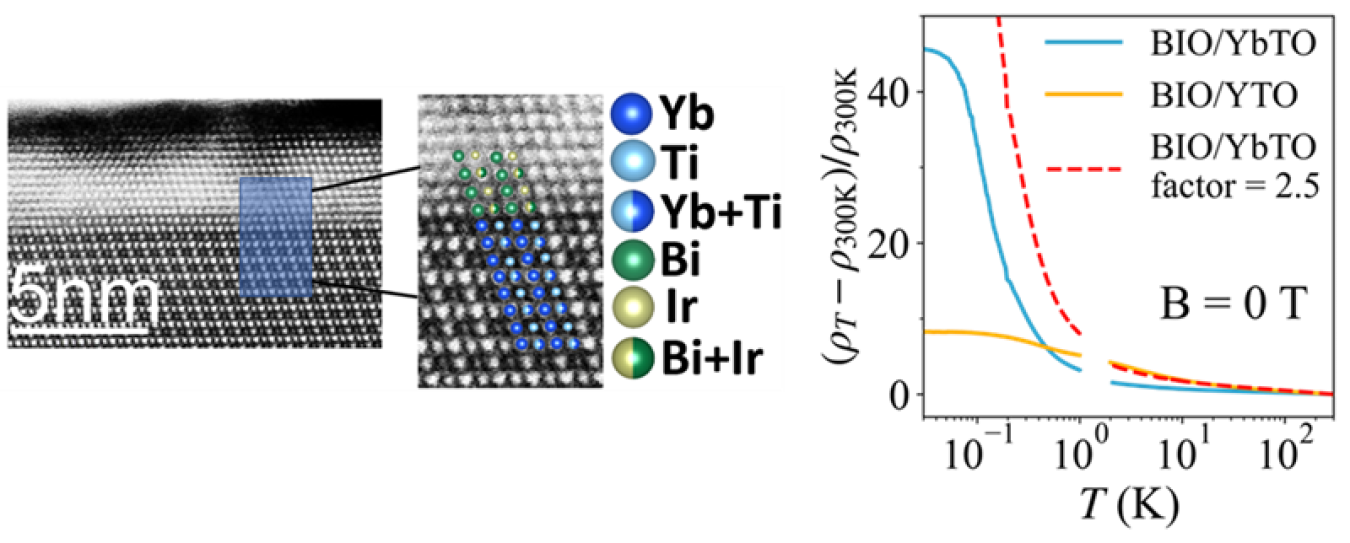The spin fluctuations of an insulating quantum magnet determine how electricity flows in a nearby metal film.
July 21, 2025The Science
Ytterbium titanate (Yb2Ti2O7 or YbTO) is part of a special class of minerals called pyrochlores. These minerals have a huge range of potential applications, from fuel cells to high-temperature coatings. Scientists are also interested in YbTO partially because they believe that its electrons are highly entangled. In other words, the quantum mechanical states of the electrons in YbTO are closely connected to each other. The spins of the electrons in YbTO show strong quantum fluctuations. This means that the electrons can collectively flip their spin through a quantum process known as tunneling, which does not dissipate energy. Researchers have now shown that this property could be used to influence an electric current, laying the building blocks for a new type of energy-efficient electronics called spin electronics. These electronics involve electrons whose spin is modified by an external magnetic field. Because YbTO is insulating, it does not have electrons that can move and generate an electric current. This makes the material incompatible with electronic integrated-circuit technology. To make the material useful for electronics, researchers grew a metal film of bismuth iridate (Bi2Ir2O7 or BIO) on top of YbTO. The electrons in BIO can generate an electric current. This electric current “feels” the effect of the spin fluctuations in YbTO and responds in peculiar ways to applied voltages and magnetic fields.
The Impact
Researchers demonstrated that when they placed a BIO thin metal film in direct proximity with YbTO, the spin fluctuations in YbTO affect the way the electric charges flow in the BIO. This means these metal-to-insulator junctions allow scientists to probe the physics of quantum spin fluctuations in magnetic insulators by measuring electric currents in the metal film. These junctions can also aid in the development of future energy-efficient spintronic devices. In conventional spintronics, reorienting the spins takes energy. However, the spins in YbTO can change configuration through quantum tunneling, which bypasses the energy barrier.
Summary
Magnetic systems with strong quantum spin fluctuations (QSFs) are interesting for two reasons. First, the quantum fluctuations are highly correlated and entangled, involving tunneling between distinct collective spin states with nearly degenerate energies. Second, such magnetic systems promise future applications in quantum devices, as the tunneling mechanism bypasses the energy barrier necessary for reorienting the magnetic moments in conventional spintronics. However, most of the known quantum magnets with strong QSFs are good insulators and thus incompatible with electronic integrated-circuit technology. Scientists face a significant challenge in probing and harnessing the quantum effects of insulating quantum magnets.
To address this challenge, researchers explored a synthetic combination of conduction electrons and a quantum many-body spin system by constructing a heterostructure of a metallic BIO film epitaxially deposited on an intensively studied insulating quantum magnet YbTO. The researchers demonstrated strong proximity effects between the electric transport in BIO and the quantum magnetism in YbTO, supported by the scaling behaviors of the resistance and its sensitivity to the anisotropic QSFs. In particular, the observed 1/T dependence and large negative magnetoresistance in the low-temperature regime do not conform to the expectations based on electrons scattering by coherent spin waves but point to the decisive role of QSFs.
Contact
Haidong Zhou
University of Tennessee
hzhou10@utk.edu
Funding
This work is supported by the Department of Energy Office of Science.
Publications
Xin C. K., et al., Anomalous proximitized transport in metal/quantum magnet heterostructure Bi2Ir2O7/Yb2Ti2O7. Physical Review Materials 8, 114407 (2024).[DOI: 10.1103/PhysRevMaterials.8.114407]. The journal’s editors selected the paper as a highlighted article.


